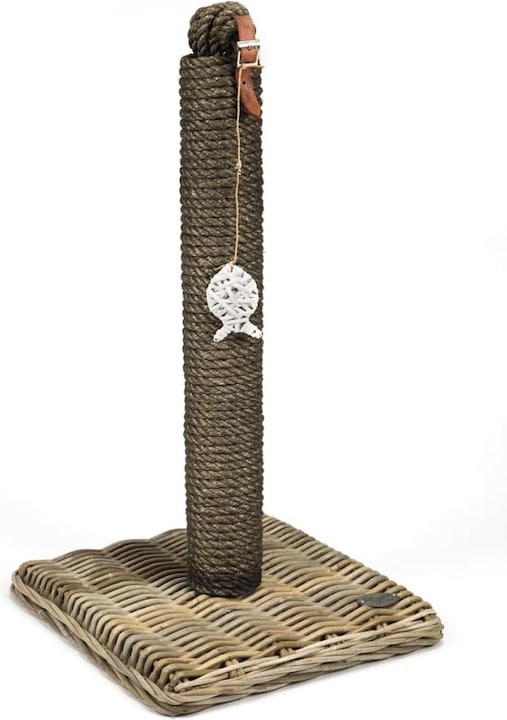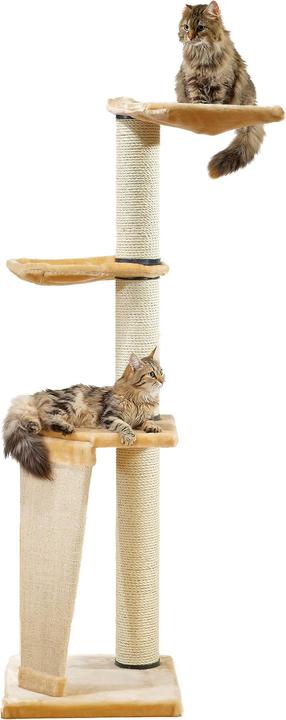

Supernanny for cats – how this animal psychologist teaches manners
Some pee all over the apartment, others use the couch like a claw sharpener. Long story short, not all cats behave as we’d like them to. Animal psychologist Katharina Aeschimann treats four-legged friends with behavioural problems and reveals what owners should and shouldn’t do.
When kids got out of hand, former reality TV fans knew Supernanny was on her way to visit overtaxed parents and give them parenting advice. Katharina Aeschimann from Winterthur has a similar job – only she teaches cats, not children.
Katharina Aeschimann, when do people call you?
Most often, it’s when the person’s cat pees throughout or marks their apartment. Problems with cats in the same household or neighbouring cats are also common. And then there’s the scratching of doors and furniture.
Let’s start with the first problem: peeing and marking. What message is the cat trying to send?
Marking is a form of communication, just like meowing or scratching. The causes are manifold and often difficult to figure out. It’s easier to find the trigger when it comes to simple peeing.
Is it a cat’s way of punishing the owner?
No, that’s a misconception. Cats don’t pee on your bed to prove some point. Maybe your cat is overwhelmed by a specific situation. Or it could be a sign of dementia or a bladder infection. That’s why the first course of action should always be to seek out a vet. If there’s a health problem, it must be treated before I get involved.
So, you make house calls?
Yes, always. I need to see the situation on site to figure out where the problem is.
What are things you might notice?
For example, that the litter box isn’t the right one for the cat. Closed cat toilets are designed more for the hygiene needs of the human than the animal.
Cats don’t like them?
No. When cats do their business in the wild, they do so in the middle of an open field. Squeezing into a tight, dark cave that stinks is something they’re reluctant to do. Open litter boxes are much better. You should place them in a quiet place.
What about self-cleaning litter boxes?
If you ask me, those are a no-go. If the automatic cleaning system switches on while the cat is still doing its business or is just about to leave the box, many will get so scared that they never use the toilet again.
As you mentioned, having multiple cats in the same household can also become a problem. Why’s that?
This often happens when a new cat is added to the household that doesn’t match the first one in terms of character or age. Cats in the same household should be about the same age – up to the age of about two. Otherwise, the differences in playfulness and physicality are too great.
And when might there be trouble with the neighbour’s cat?
Unpleasant encounters often occur in neighbourhoods with a lot of cats. As cat density is on the rise in general, so are the problems. Some cats are real «bullies» – or victims. One of my customers even moved because of this. They encountered problems again at the new place.
How did you go about solving the issue?
We created a going-out plan for the cats to avoid having the two meet. This worked because the neighbour was also willing to help out.
Which cats often have problems?
Bottle-fed animals raised as «only children» often show less social behaviour because they couldn’t learn it alongside their siblings. In general, the most problems occur with apartment cats.
How come?
Often, they’re not offered enough activity. If your cats can’t go outside, you have to offer them alternatives: suitable toys, food puzzles and, above all, a good scratching post.

Source: Darina Schweizer
What should you look for in a cat tree?
In any case, not aesthetics. There are many scratching posts that look like designer objects, but are completely unsuitable. A good scratching post should have an uninterrupted scratching surface of at least 80 centimetres in length. Cats usually don’t like to lie on narrow tiered boards, preferring instead to lie in high-level hammocks with a good view. The cat tree is best placed by a window with a view outside.
And what food puzzles do you recommend?
There are, for example, programmable feeders that spit out dry food. However, in my experience, these often don’t work optimally. It’s easier to put food in bottles or toilet rolls from which the cat has to then fish it out. You can also hide dry food around your apartment or keep your cat busy with clicker training. The latter involves sounding an audible signal when the cat exhibits correct behaviour and then rewarding it.
We haven’t talked about scratching yet. How can it be solved?
First and foremost, with consistency. If your cat scratches your door at night, you have to ignore it without exception. The same goes for meowing. You may have to reach for earplugs. If you show even just a tiny reaction, the cat will continue. Scratching is often already part of a ritual.
What do you mean?
Certain cats make the same rounds in an apartment every day; for example, they eat, scratch the sofa and then go outside. The key here is to interrupt the ritual by feeding the cat in a different place, placing something in front of the scratching post, or moving the furniture. This often works wonders.
How often do you work wonders – that is, what’s your success rate?
I can’t give anyone a guarantee, but in most cases I do achieve a significant improvement in the situation – provided that the owners join in and stick to it. That’s the be-all and end-all. If during our follow-up phone call after about three weeks, the owner tells me they haven’t got around to changing anything yet, then most likely the situation won’t improve.
What increases the chance of improvement?
The sooner you react and get professional help into your home, the better. Otherwise, the behaviour may become so ritualised that it’s nigh impossible to break.
Finally, one last personal question: you have seven Maine Coon cats of your own. Do they behave impeccably?
No, I let them do just about anything, so they’re probably not a good reference for my practice (laughs).
What do you think of the animal psychologist’s tips? What problems do you have with your cat? Let me know in the comments!
40 people like this article
I like anything that has four legs or roots. The books I enjoy let me peer into the abyss of the human psyche. Unlike those wretched mountains that are forever blocking the view – especially of the sea. Lighthouses are a great place for getting some fresh air too, you know?










